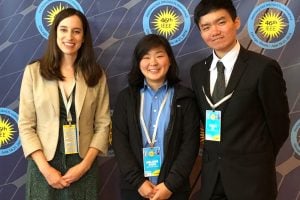
Two students from the NanoEnergy Laboratory presented research at the 46th annual IEEE Photovoltaic Specialists Conference, held June 16 through 21 in Chicago. Arlene Chiu and Lulin Li, both doctoral candidates working in Susanna Thon’s laboratory, viewed the experience as valuable.
“The PVSC is the pre-eminent conference on photovoltaics (solar cells) in the US,” said Susanna Thon, an assistant professor of electrical and computer engineering who serves as the laboratory’s principal investigator. “It is a great chance for students to meet leaders in all areas of photovoltaics and to broaden their perspectives on the exciting advances happening in the science and applications of solar energy.”
Both presentations at the session were well received, and Chiu’s was named as a finalist for the conference’s “Best Student Presentation Award.”
Chiu’s talk, “Photonic Band Engineering in Absorbing Media for Spectrally-selective Photovoltaics,” focused on the use of photonic crystals to manipulate the transmission, reflection and absorption spectrum of a photovoltaic material. The idea is to control the spectrum of a material so that it selectively absorbs and transmits specific desired colors of light. The work has potential for applications in multi-junction solar cells and transparent photovoltaics.
“It was pretty exciting to be a finalist for the Best Student Presentation Award. They even mentioned that my abstract was one of the highest rated submissions at the opening session,” Chiu said. “This says that the research that we’re doing in Susanna’s lab are ideas that could really impact the rest of the field.”
Li’s presentation, titled “Spray-Cast Electrodes in Colloidal Quantum Dot Solar Cells for Portable Solar Energy Manufacturing,” was also notable. His talk focused on making liquid-phase solar cell materials, including the electrodes and light absorbing semiconductors, and spray-painting them directly onto any sun-exposed surface to generate electricity. This work makes it possible to fabricate solar cells on flexible substrates, wearable device skins, automobile surfaces, or directly onto urban infrastructures.
It was a big moment for Li, as it was his first presentation at a conference.
“I was very excited about it,” Li said of his talk. “This presentation helped me to make progress in both communication and my expression skills.”